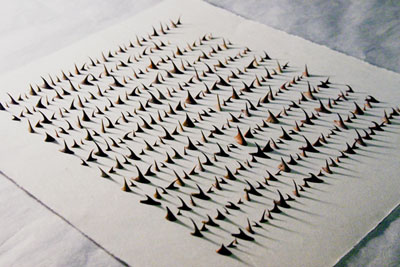| --------------------- WORK ------------ ABOUT ------------ PRESS ------------ NEWS ------------ LINKS ------------ CONTACT |
PATTERNS AND PATHWAYS: CUI FEI GET TO KNOW: CUI FEI 6 EIN FANTASIETEXT AUS 6 CUI FEI 6 6 INTERVIEW WITH CUI FEI 6 NATURE AND CALLIGRAPHY 6 CUI FEI
TRACING THE ORIGIN 6 TAKING ANOTHER LOOK 6 6 ARTIST OF THE MONTH: 6 6 A LOOK AT CUI FEI 6 SEVEN ENIGMATIC 6 REASON'S CLUE EXHIBIT 6 WHERE BRIEF WORKS 6 CUI FEI AT GALLERY 456
/////////
AN INTERVIEW WITH
|
SEVEN ENIGMATIC SCULPTURES—EDITOR’S PICKS by Robert Ayers
NEW YORK—Lately I’ve found myself enjoying a whole range of enigmatic sculptures in New York. Whether in the uptown museums or Chelsea galleries, there are some splendid exhibitions currently on view. None of the works I’ve gathered here simply “sits on its ass,” as Claes Oldenburg once put it: They clamber up walls, spill across floors, or pretend to be furniture, playthings, or manuscript pages. What they have in common is that they are static objects, or arrangements of objects, that await our contemplation: That is, they are all good old-fashioned sculptures, something that’s become harder to find as enthusiasm for interdisciplinary and technology-driven work has grown. In almost every other regard, however, these seven works could not be more different.
Cui Fei, “Read by Touch”
|
